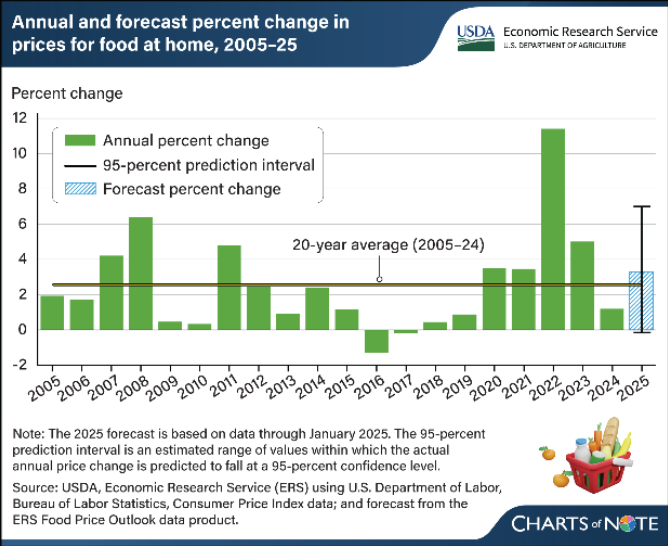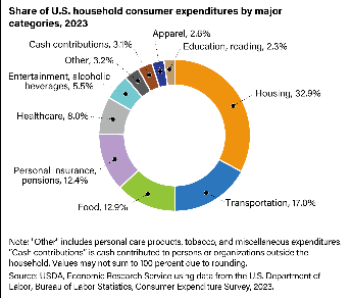Published March 11, 2025
These days, it’s a common experience to walk into the grocery store and experience sticker shock. For months, everyone from news outlets to economists has been discussing rising grocery costs. We are all doing what we need in order to make ends meet before getting to the checkout line — from adjusting budgets to foregoing favorite snacks altogether. For some, that means even skipping meals.
Grocery Prices Are Rising in 2025
According to the U.S. Department of Agriculture (USDA) Economic Research Service, grocery (food-at-home) prices have grown on average 2.6 percent per year over the last 20 years (2005–2024), but in 2025, grocery prices are expected to increase by 3.3%, outpacing this historic average. This follows several years of rapid rises in all food prices (both food-at-home or groceries and food-away-from-home/restaurant purchases): between 2020 and 2024, all food prices rose by 23.6% during the COVID-19 pandemic and economic crisis. Grocery prices rose the quickest in 2022 at 11.4%, the highest since the 2008 Great Recession, when grocery prices increased just over 6 percent.

Food prices are continuing to rise at a time when households are already making tough decisions and stretching their budgets to the limit. In 2023, U.S. households spent an average of 12.9 percent of their income on food, the third largest expense behind housing (32.9 percent) and transportation (17 percent). Altogether, basic needs — housing, food, health and transportation—70 percent of the average household budget that year.

The squeeze is even tighter for households with low incomes, who spend about 30 percent of their income on food, far above the 12.9 percent national average. For families already struggling to make ends meet, rising grocery prices just don’t mean cutting out luxuries — they mean making difficult decisions between necessities like food, rent, medicine, transportation, and child care. These tradeoffs are the circumstances that create food insecurity in the U.S., the experience of 47.4 million people in 2023.
But instead of providing relief to the American people, some in Congress are pushing to cut the Supplemental Nutrition Assistance Program (SNAP), America’s first line of defense against hunger and food insecurity in the U.S., that provides direct support to over 42 million people.
SNAP Is a Critical Response to Rising Food Prices
SNAP reacts quickly to the economic crisis. In 2020, the government provided emergency allotments to SNAP households through the Families First Coronavirus Response Act, preventing a surge in food insecurity as millions lost jobs. In 2009, Congress temporarily increased SNAP allotments during the Great Recession, as part of the American Recovery and Reinvestment Act, improving food security and stimulating rural economies through increased economic output and job creation. In each instance, the impact was undeniable: Households had the resources they needed to put food on their table and meet their basic needs.
Despite its proven track record, some in Congress want to cut SNAP significantly. If these cuts go through, millions of households, including those with children, older adults, people with disabilities, and veterans will lose critical benefits at the exact moment when grocery prices are climbing. These cuts will only force more impossible choices between food and other basic needs.
What Can You Do?
- Contact Congress. Tell your representatives that you oppose proposals to cut or restrict access to SNAP. You can find and share data on why SNAP matters to people in your state by downloading your state’s fact sheet.
- Take the SNAP Challenge March 18-20. See if you can get the nutrition you need on the average SNAP benefit, which is about $6 per person per day. Your participation will send a strong message to Congress that SNAP needs to be strengthened, not weakened. Share your journey on social media and with your elected officials using the SNAP Challenge toolkit.
We’re all feeling the squeeze at the grocery store. But for tens of millions of families, SNAP is the difference between getting by and going hungry. Cutting SNAP would make an already difficult situation worse. Now is the time to act — to protect SNAP, to reduce food insecurity, and to support local economies.

